Shapiro in Borkle

One of the stranger named games, Borkle, is just as strange to Eurakarte himself. The description states that he doesn't remember where this one even came from. He claims it may be another stab making a Mr. Shapiro Cares Not For Lies sequel, and it doesn't take long to see why.
Borkle is very much designed similarly to the mountains and forests seen earlier. Shapiro still gets to wander freely around several boards, though this one is more of a basic adventure rather than an RPG. Combat is now simply shooting at enemies that rush the player. It's a bit of a step down, though not so much that the game isn't worth your time.

The big difference here is that Shapiro has people to interact with that don't want him dead! "Borkle" is the name of a planet, where its two tribes, red and blue, are currently feuding with one another. Shapiro, being a part of neither group, is able to freely travel between two settlements. Don't expect to him to mediate any peace between the two though, him and his friends opt for neutrality, taking no interest in the local politics.
It's very unclear what you're doing on this planet since it's not a mission of making peace. It's only at the very end of the game that players find a weird energy generator left by Dr. Kabadbot that needs to be destroyed and its gemstone power source requisitioned. Kabadbot himself is once again left unseen, but his name comes up a good amount. One of the villages has been made to worship him as a god. This still has no impact on how Shapiro interacts with the reds and blues, nor how they perceive him.
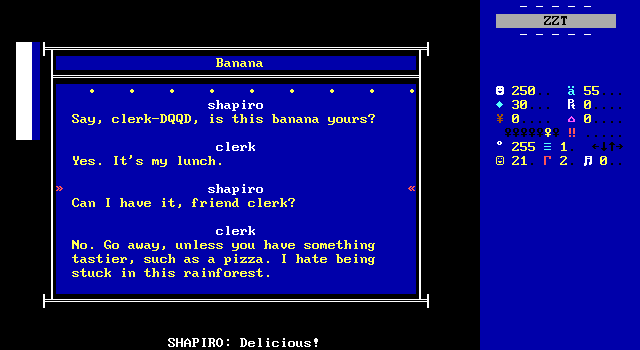
There's some puzzle solving to be had here as well. Multiple fetch quests are ongoing simultaneously, giving players a number of options for what to work on at any given moment, though the logic behind them is a little too obtuse to really follow. At one point Shapiro gives a man a fruit, thus feeding him for the rest of his life. (The fruit poisons him and he dies on the spot.) Fair enough.
This in turns gets players a bucket that prior to the poisoning was entirely unmentioned. The bucket is then used to get a ball lost by a child out of a well. The child doesn't mention the ball going in the well, and examining the well without the bucket makes no mention of anything at the bottom other than water.
It's not too terrible. These examples have logical beginnings, using a bucket on a well or giving fruit to a hungry guard are perfectly reasonable actions. The trouble is just that you never know why you're doing these things beyond a prompt showing up indicating that you can. There's never a moment of realizing that if you could just find a way to get X to give you their Y, then you'd be able to use that on Z to reach a new screen.
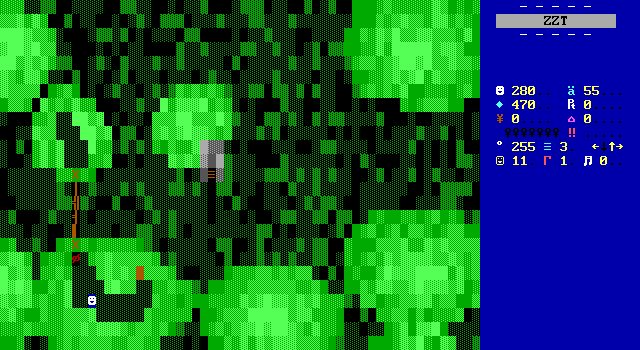
As the game progresses though, I found myself looking up what some items were for. A sad child who lost his ball is obvious. A priest that needs to sweep the floor but has nothing to sweep with gets the broom. By the end these connections stop being so intuitive, and you'll find yourself throwing a ball of dough into a camp fire to transform it into an entire pizza.
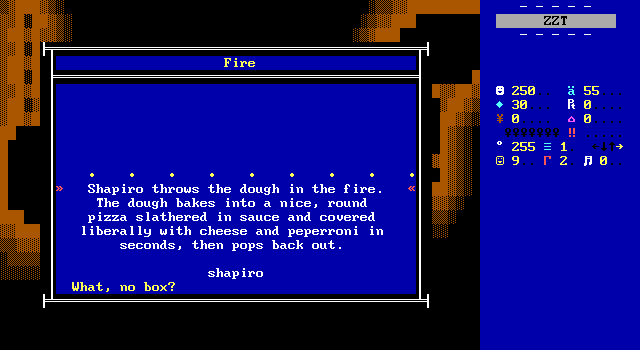
To Karte's credit, one of the game's best laughs come from this puzzle.
The biggest hurdle though is that there's a ton of backtracking from village to village and other locations. Shapiro is constantly acquiring one item, then having to turn around to use it to get another item, then heading back to where he was to make another inch of progress. Forest/Mountains didn't have much that could slow players down other than missing a switch. Here, even playing the game perfectly means a lot of criss-crossing boards long since devoid of enemies to fight. And if you don't know exactly what each item should be used on, you're very likely to find yourself making numerous unnecessary trips.
Even dave2, circa 2002, agrees.
The difficulty of knowing where to go next is made slightly more annoying by how similar both town's exteriors buildings are. I found myself going to the wrong town looking for a specific building. Not to mention both buildings in Redtribesville using the same passage color, causing players to always return from an interior scene to the lower-rightmost building's passage. It can get a little confusing, or maybe I've just got poor spatial awareness.
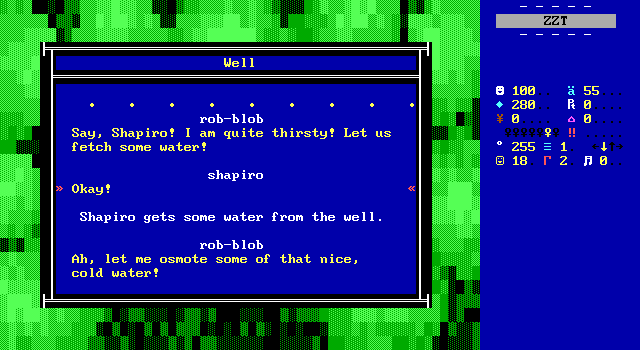
As is often the case with rambly ZZT adventures, there's still plenty of entertainment to be had when things are running smoothly. Borkle might not be as technically impressive as previous games in the compilation, but it's still a planet worth visiting. Eurakarte's characters work in ZZT due to the writing first and foremost, making them flexible enough to be dropped into pretty much any genre imaginable. Borkle is a bit slow, sure, but it continues to deliver on laughs and unexpected outcomes to make it a memorable experience.
Mr. Shapiro Cares Not For Sidescrollers
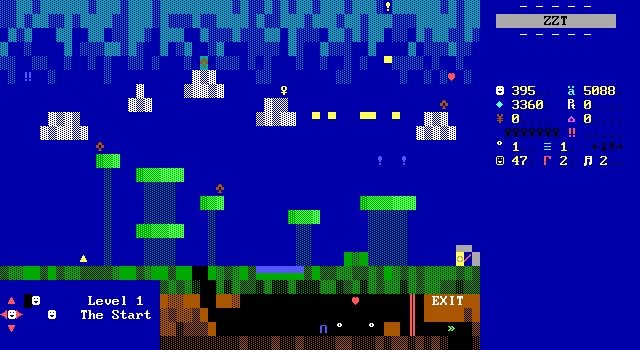
Eurakarte introduces another engine-based game, this time tackling the challenge of ZZT platforming. Once again though, he nails it. Of all the object-controlled ZZT platformers I've played, this is second in quality only to Sid's Disaster. The challenge, as always with ZZT's platformers, is how to tame the chunky tile-based movement into something that feels responsive for players to control.
Commodore would do this in Sid's Disaster by having Sid's movements be very precise, with fixed jump angles, allowing players to learn the arc and position themselves in the right spot for their leaps to work. Combined with climbing, hanging, and rope throwing mechanics, the game was designed around levels that tasked players with coming up with a route to reach the level's end, removing the difficulty of executing that plan almost entirely.
Karte goes for the more traditional style of platformer, giving players the ability to control their trajectory in the air to try and steer to the next platform. Again, good design saves the day. The jumps players are expected to make are well without the range of what Shapiro can do. Precision is saved for reaching optional items to boost your score.
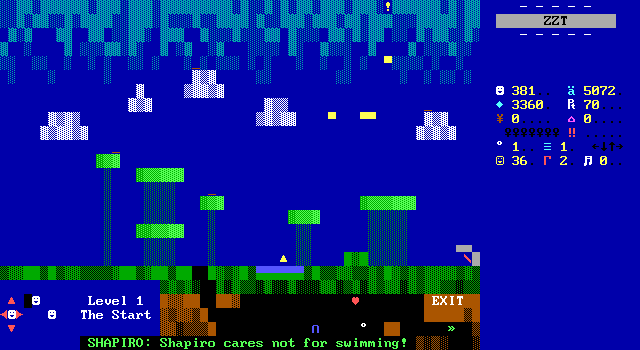
Karte mostly avoids another common issue by preventing instant deaths. Bottomless pits appear in just two levels, the final one and an earlier cloud stage where the cloud coverage makes it unlikely for players to actually fall to the bottom. Instead, when Shapiro plummets onto spikes that are just as pointy as he is, or splashes into pools of water, (I guess he can't swim. He is a triangle after all.) he'll simply take damage over time until he can manage to return to less harsh terrain.
This is great as the one issue Karte's engine strangely does fall victim to is that the player is surrounded by objects at all times and thus can't load a save in vanilla ZZT due to the player being unable to unpause if they can't move. Action used player clones for touching control objects, leaving the actual player to move around in a tiny region of the board. The same thing could have been done here to permit mid-level saving and make any attempts at going for precise jumps a lot more gentle if failed. So while players won't plummet to their deaths, they do have to re-climb to where they fell from time and time again until they get their prize or just give up on it.
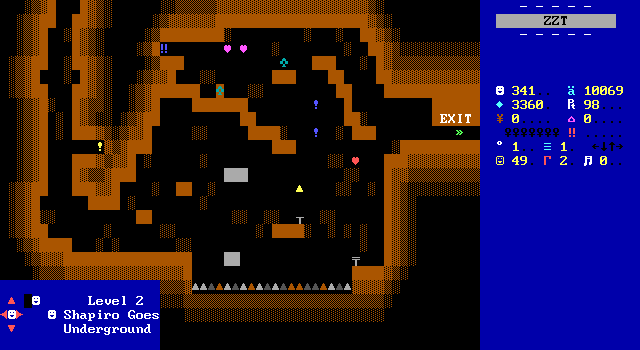
The expected obstacles show up to stop Shapiro from reaching the level's exit. Some brown ruffians pace about, biting Shapiro if he gets close, but being vulnerable to being stomped on (cutely turning into an underscore character before they die, fulfilling their goomba-like obligations). There are moving platforms that players need to keep up with as they shift from side to side. Vertical ones as well, though standing on a platform that wants to move up prevents it from doing so, which can be a bit awkward.
There are falling blocks which force players to move quickly and pay attention to when they start falling as once they crash they vanish forever. The game is kindly not designed to ever require players use these blocks for anything other than power-ups.
Some springs which I always associate with Freak Da Cat make an appearance as well, launching Shapiro vertically when stepped on, which are used for the some of the more tricky jumps in later levels.
Players are given a high level of control over Shapiro. ZZT's #walk is used to apply gravity every tick, and reversed when Shapiro needs to jump into the air. This allows the object's code to still move horizontally in the same cycle, making it much easier than normal to cover large distances, or do some physics defying maneuvers where Shapiro jumps up, shifts forward to avoid bumping his head, then shifts backwards to land safely atop the obstacle. It feels good to do. It's all very well executed, and yet Karte has one more trick up his sleeve.
When Shapiro is in mid-air, shooting left or right performs what can only be called an air-dash. All vertical momentum ceases as the player zips horizontally in the specified direction. This gives the game some level of snappy platforming as seen in Sid's Disaster, but can be employed as players see fit rather than as a requirement. Realize your jump was a tad short? Dash aside and maybe you'll land where you had originally hoped, or at the very least, fall and land on soft ground rather than sharp spikes.
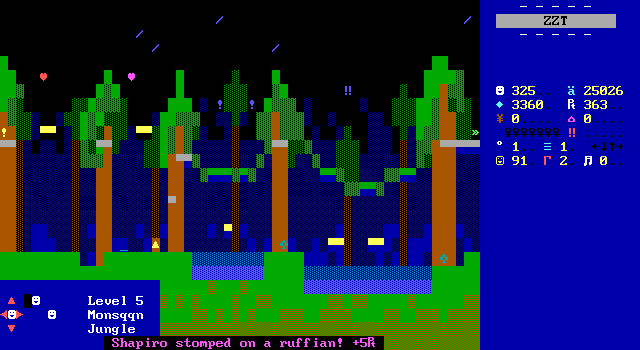
The levels themselves aren't too bad either. Karte keeps things colorful, avoiding stark black backgrounds even in the underground stages. Not to mention a fancy rain animation in the jungle stage. The levels increase in difficulty gradually, and like with CraNKGod in Action, each level here has a premium bottle of Gold Blue When to collect for points and bragging rights.
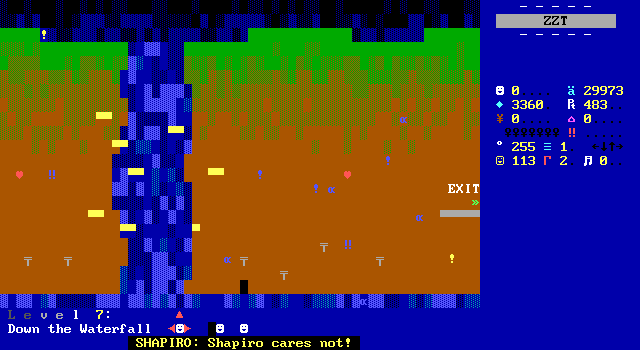
The only things to complain about here is that the final level does fall prey to the issue of demanding jumps off springs with no room for error. It might be for the best that this is where Eurakarte stopped making more levels if this was a sign of things to come.
Beyond that though, Sidescrollers also suffers from a general lack of theme. Action was able to introduce humor through its collectibles. In Sidescrollers everything is Blue When or health puddin'. Change the yellow triangle to a and you could convince anybody that this was Freak Da Cat 3. There's no gags, no commentary from Shapiro, and none of the other members of the cast make an appearance.
A full release could absolutely have had identical gameplay and inserted some interstitial art boards or cut-scenes that would have gone a long way to making this a memorable platformer for reasons other than its code. What's here is a solid foundation with real potential, that currently is too generic for its own good.
Mr. Shapiro Cares Not For Discovery
The final two games included in Year of Shapiro are both previously released 24 Hours of ZZT entries, both named for their respective topics.
Eurakarte immediately gets bonus points from me for not just including the games, but the scores received and judges' commentary! The submissions for these contests are (mostly) well preserved, their results far less so. I only wish more 24 Hours of ZZT re-releases were so thoughtful as to include this information with them. (Granted this one winds up being a 24HoZZT whose scoring breaking is still hanging around.)
Placed 12th out of 33, getting scores of
8, 6.7, 5, and 4. The comments were:
- "Mr. Shapiro is back and he cares (not)!
A very funny entry, imo. It had some
good gameplay and graphics, too."
- "psychiatry would help you. good
gameplay."
- "FunSilly!"
- "i like the mr. shapiro games, but this
one was real short and easy. F MINUS"
• • • • • • • • •
Discovery is stated to have gotten 12th place out of thirty-three entries, a respectable spot back when those contests were getting so many submissions.
The scores received are curious to me. Especially the harshest judge's comments. I found the game to be of reasonable length for something made in a day, and kind of a pain to actually get through. More of a B MINUS.
Shapiro and a few of his pals (Shapiroette is MIA, probably kidnapped by Kabadbot in a different game) have driven out to the Safara desert to find discover its three lost treasures and place them on a shelf for display. The game takes place across eight boards, with a bit of backtracking (much less tedious than in Borkle) as you once again find items and find places to use them.
Unsurprisingly given the time limit, the game isn't very polished. If Borkle is a step down from Lies 2, then Discovery as well as the yet-unseen Revival are a step down from Borkle. Compared to the others, your options for where to explore next are extremely limited, with the game being about finding ways past obstacles until you reach the next one.
Some of these obstacles have the misfortune of coming down to busywork in order to get past them. To obtain a needle with which to stab a vendor repeatedly instead of buying his overpriced adventuring supplies (obviously) Shapiro needs to investigate a specific cactus identical to all the others on a certain board. There are only a few to investigate, but the others all provide an identical canned response, so it's unlikely players will touch every last one. Making things worse, is of course that it's another obtuse solution. At no point do players think they need a needle, and I doubt should they stumble across it that they'd think it was meant to be used to stab a vendor.
I had to consult the file viewer a number of times to get through this one. Using it to confirm where you should be going before you mistakenly go somewhere else, the game ends up being decent enough. Unlike Borkle, there aren't too many places to actually go. You've got the desert screen, the vendors in the cave, a locked up and seemingly abandoned nuclear powered factory, a dungeon, and then the bottom of the cave where all the power plant workers can be found. The small scale does help with the puzzle solutions at least, as there are really are so many things to interact with, even if you're blindly touching everything around in hopes of something new happening.
The factory's offices are the highlight of the few boards here. These seemingly abandoned cubicles and break rooms have been left wide open giving Shapiro and friends the chance to explore every nook and cranny, uncovering items and solving basic key/lock puzzles with them. The usual files can be read to get some clues as to where everybody went, and lots of opportunities to try and get players to laugh. It's the one part of the game where it really feels like players have something to do other than talk with people.
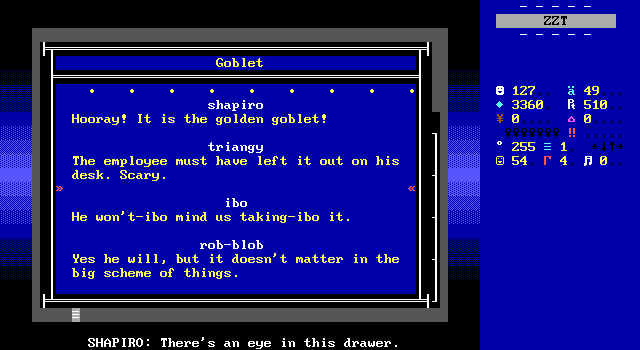
My expectations for ZZT comedies, especially the "random" humor ones are so incredibly low at this point given how poorly they usually fare. Year of Shapiro is a welcome change, where at least once per game something will get me good. That this compliment extends even to hastily made 24 Hours of ZZT games is nothing to scoff at. Even with this little time to develop something, Eurakarte can still come up with some good lines. I'm surprised at how mediocre the scores seem to have been when the game is a successful comedy to me.
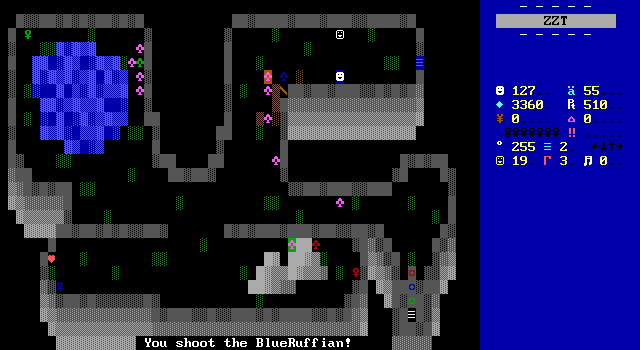
For those that don't get much out of the puzzles, which are more of a vehicle for comedy, the second level of the cave is fashioned after a good old fashioned ZZT dungeon crawl. Yet even if action is more to your tastes, you'll still be wanting more after this single attempt at giving players something to shoot.
There's nothing particularly wrong with it. You get some faux-ruffians and a few mini-boss faux-ruffians in red, blue, and green that drop the keys to the next floor. Using these imitations rather than the real thing isn't just a symptom of the ZZT's built-ins being seen as newbie-ish, Eurakarte tries to make them a little more interesting. The big thing of course being that when one gets up close to the player to attack, they don't destroy themselves in the process. Instead, they hit and run, dashing backwards to avoid endlessly attacking the player until they can gain some distance to fight back.
As always, these little bits of extra care Karte puts in are greatly appreciated. When players have no form of melee attack, as is the case here, it's important that they be able to disengage in order to be able to actually shoot.
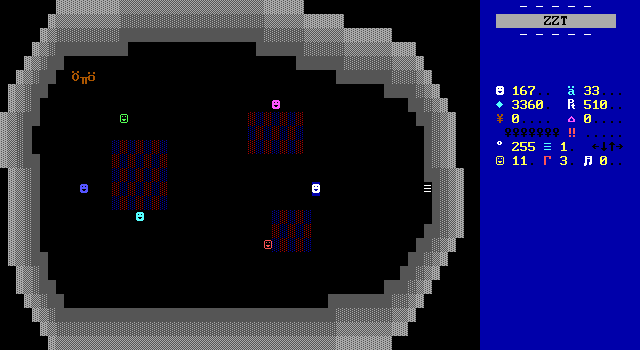
At the lowest level of the cave, players get to check out the company picnic. It's likely that this is when Karte realized his deadline was rapidly approaching as suddenly people are happy to simply give Shapiro items freely, save for one person that needs to be hypnotized using a watch that is freely found lying on the ground in the same room.
The time limit of course hurts the game, but by 24 Hours of ZZT standards, I think Eurakarte did a great job here. It was funny. It offered a lot of objects to interact with, both NPCs and inanimate objects alike. There was a hint of action that got the job done and wouldn't have been out of place in a lengthier adventure. Figuring out what to do next is the only part of the game I struggled with, and as the game progressed and the number of things left unsolved narrowed, it only got easier.
Granted, I'm basing this on having recently played only one game from this competition, but I can't help but feel like Eurakarte should have scored higher. Twelfth place is certainly respectable, but Discovery has a lot of content without feeling like it's copying and pasting something like the dungeon board ad nauseam. That kind of design is easy to stretch out for those going for quantity over quality. Eurakarte sprinkles it in as a nice diversion and pre-emptively keeps any judges from being able to complain about the game being nothing more than reading text with no danger faced by the player.
It's a straightforward game with a lot of appeal given the time limit. If Karte hadn't gone out of his way to make it clear that it was a 24 Hours of ZZT game, I'd absolutely have believed this to just be the start of another unfinished project like Borkle, just one that didn't get very far before interest waned.
Mr. Shapiro Cares Not For Revival
The last game of the batch is Karte's second 24 Hours of ZZT Shapiro game. For the very next contest Karte returned to what had done well for him, and tuned it up a little. Just as before the game is directly named for the topic, with Karte including another copy of the scores and feedback the game received.
Placed 6th out of 22, getting scores of
65, 65, 75, and 72. The comments were:
- "you are so fucked up, heh heh;
otherwise, very good."
- "I still find this quite funny, and the
graphics are leet.. but if it goes on
anymore its going to be as funny and
original as 'all your base'."
- "I may be weird but the Shapiro games
are really funny. :) Nice graphics,
too."
- "Another Mr. Shapiro game. Not bad at
all, although I didn't find it as funny
as some previous Mr. Shapiro games."
• • • • • • • • •
A small improvement in the score over what seemed to be a well-received entry previously, but in terms of positioning, Mr. Shapiro Cares Not For Revival was no slouch!
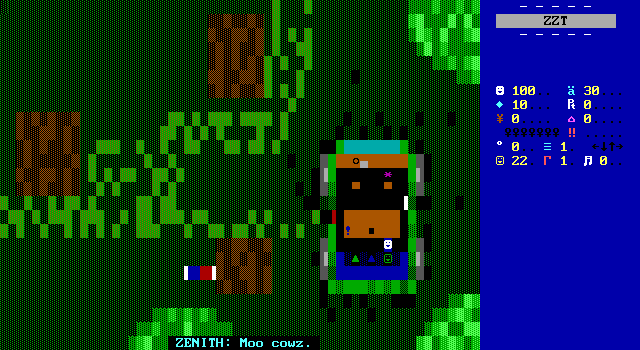
Karte established a formula previously, did well, and only continues to refine it here. There's a definite sense of deja vu upon starting the game and once again finding Shapiro and friends sitting in a parked jeep. For those playing these games as they were released, there was a months long gap between Discovery and Revival. For folks playing the collection, that gap is now gone, which had me worried Karte was going to simply rehash the previous game with only the minimal changes need to keep it relevant to the new topic.
There's no reason it couldn't be done. A number of ZZTers reiterated on previous 24HoZZT entries or created pocket-sized sequels to their existing games. Knightt's Stupid RPG comes to mind, as does myth's first-ever 24HoZZT winning Night Planet with its sequel emptyspaces. Karte had solid groundwork and beloved characters. Why not stick to what worked?
Eurakarte's 24hoZZT entry on the topic of
"Revival".
amazing air-jeep to fly to a small
village in a random South American
nation for a nice vacation. However, when
they arrive there, they discover the town
is besieged by zombies n' bad stuff.
After asking around in the town,
Shapiro has discovered that the minions
of Q'uapla Jahosaphat, an EEEVILL bad
dude that tried to take over the world in
ancient times, are trying to ressurect
him. The only person that can stop them
before he is raised is SHAPIRO! Can he do
it?
If he can, he'll have to break into
Q'apla castle, once a tourist spot, now
mysteriously blocked to the public. Good
luck, Mr. Shapiro!
• • • • • • • • •
This time, rather than hunting down treasures, Shapiro's vacation is being ruined by sinister forces working to revival an ancient evil tyrant. Shapiro will still be exploring a small area now searching for keys to the closed off castle. As before items needs to be found and enemies need to be shot, with the mix of action and exploration being a lot more evenly distributed than before.
Despite the initial story seemingly having nothing to do with Shapiro himself, eventually it's revealed that this plot is being masterminded by Dr. Kabadbot, finally making his first appearance in Year of Shapiro. Jahosaphat happens to be an ancestor or his, defeated of course, by an ancestor of Shapiro's. Kabadbot isn't all that exciting of a villain, but it's nice to finally see the last member of the main cast slide in at the last minute.
In Revival, Karte introduces some fresh ideas that give the game more depth than Discovery. One of these ideas feels admittedly out of place in a game as short as this, that I would love to see implemented in something lengthier. The "PB Health Club", of which Shapiro is a card-carrying member, is the game's take on a store. It's used to replenish health and ammo as you'd expect. Where it differs though, is that the only thing you can buy is both health and ammo simultaneously for three gems.
Hidden around the world are advanced and premium membership cards that let Shapiro get more supplies for the same cost. I think this is a great way to speed up shopping rather than constantly having to navigate menus. And since how many levels of membership there are are kept hidden, players are less likely to be stingy with their spending, waiting for the better deal to become available. Instead, they'll actually make use of the shop.
The small layout of Revival means that players will frequently pass through the village with PB's, so there are constant opportunities to spend some money without having to make a trip out of it. I would love to see this in a full length game. Here, its potential seems wasted, as while there is more shooting than Discovery, it's still an easy game where there's little need to shop. Even if players never find a better card, the game hands out enough cash that you'll be hard pressed to actually be in danger of running out of health or ammo.
Another fun aspect of having to find the cards, is that it makes it genuinely exciting to come across one. It's not often ZZT games give players a permanent upgrade like this. There's a little moment of triumph when you notice a mismatch between an interior board's depiction of the outside and what players actually see out there. Investigate the seemingly empty spot, and the savings are passed on to you!
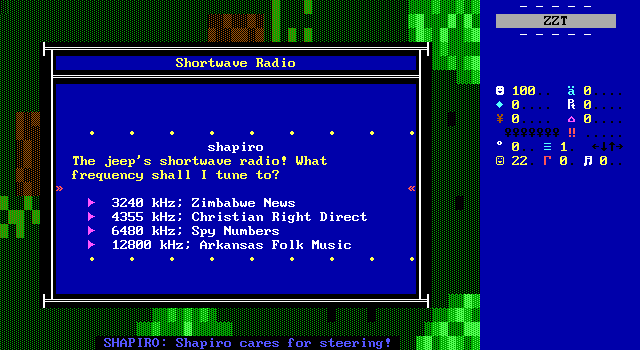
Another example of Eurakarte steeping up for game is how in Revival he manages to make the jokes more than just jokes. The jeep's radio at the start offers a variety of stations for Shapiro to tune into and provide his thoughts on. It seems like it's just there for the novelty of tuning into a numbers station or rocking out to the (sadly unplayed) "Arkansas folk music", but later on a code book is acquired and the numbers station winds up being a necessary broadcast to listen to in order to find out a password used within the castle.
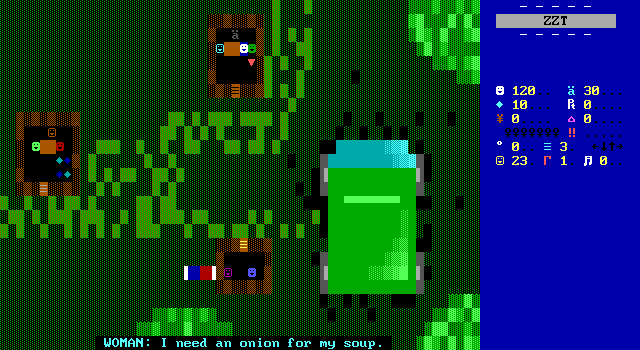
It's not all brilliance. The item hunting is about as arbitrary as ever.
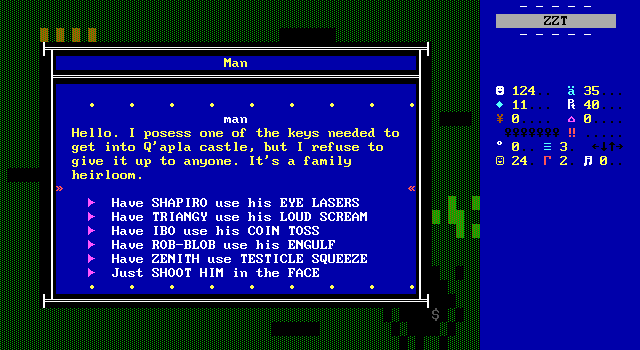
Sadly, the RPG engine does not make a return. Just a gag fight of assaulting a random man to get one of the game's keys and trying to figure out which one he's actually vulnerable to.
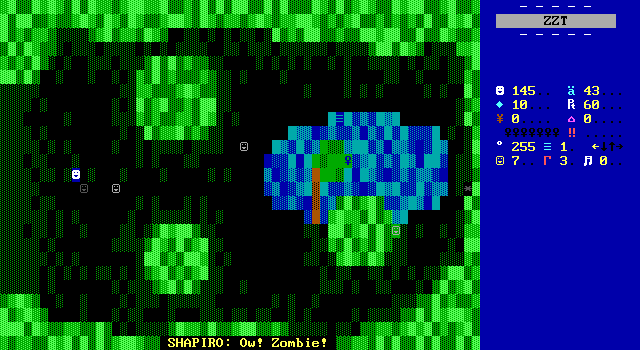
For actual combat, the good news is that there's more than a single board of fighting. The bad news is that it's still not all that interesting. Zombies by the lake are basically the same as the faux-ruffians before, except they now take two bullets to bring down as stagger randomly rather than away from the player as the mini-boss ruffians did.
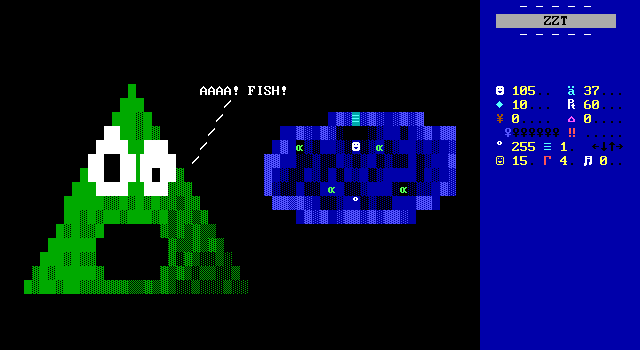
Another villager promises to give one of the keys to the castle in exchange for a pearl, which means Shapiro gets to jump in a lake. The fish wind up being a much larger than than the undead on the surface thanks to the significantly smaller area in which they're fought as well as some very erratic movement that can make them hard to land a shot on.
Perhaps realizing that there's only so much you can place in an underwater ZZT environment, Karte opted to keep the lake small rather than needlessly empty, and took advantage of the empty space to depict Triangy screaming as he so often does.
One of the tiles flickers, telegraphing a hidden cove with some health and gems. It's nice when a board's space doesn't all go to waste.
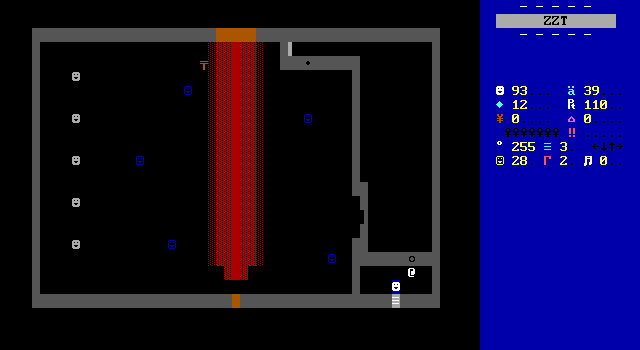
After collecting all the keys, burning down a down thanks to a siphoning system and tank of kerosene, as well as cracking the code of the numbers station to get the password to the revival experiment Shapiro can finally confront Dr. Kabadbot to stop his evil scheme. After hearing about Kabadbot's tragic backstory of course.
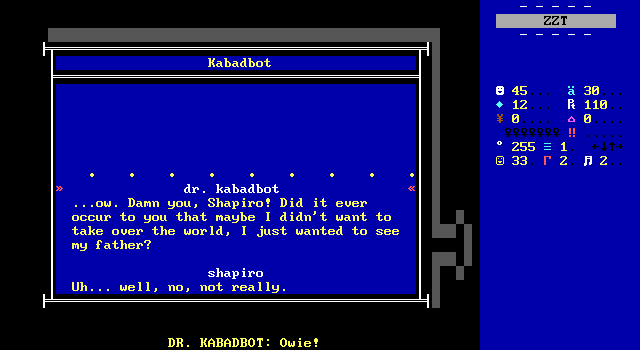
It's clearly another gag rather than trying to make Kabadbot sympathetic, but Shapiro cares not and attempts to stop the experiment from getting underway. Alas it is already too late.

...But the experiment fails, triggering an incredible explosion which Karte breaks out some invisible wall trickery to animate. It looks good, and it's pretty funny how everybody is in a panic at this point, caring not for the success of the experiment.
This does mean that the entire game was a wash. Shapiro and his friends failed to sabotage an experiment that was already doomed to fail. The characters even call out the pointlessness of their adventure. In general, I'm not a fan of the player's actions amounting to nothing more than a rug-pull. Here though, the entire game was barely fifteen minutes long. I didn't exactly feel like I overcame any major obstacles trying to stop Kabadbot so much as I went through the motions of going from point A to point B in search of keys.
Though I still question the elaborate PB health club membership for a game this brief.
Despite being half the length of Discovery, Revival is the clearly superior Shapiro experience. With the downtime basically removed, Revival flows much better. The game is funnier, and its story makes more sense. When you consider how tiring it can be to play dozens of ZZT worlds in a row for judging duties, it's no wonder this one placed so well. Nobody's time was wasted, there were some novel ideas, you had a better mixture of action and puzzle-solving, and it looked less drab. Heck, given how bad the backtracking got in Borkle, this one might be the best game in the collection's second file.
Mr. Shapiro Cares For That RPG Engine
In hindsight, it's really surprising to me that Eurakarte wasn't a bigger name in the community. Not that he went unnoticed, being active on forums and IRC. His characters seem to have been remembered more than the actual games they starred in. I recall being impressed at the quality of the mini-games and engines featured in Mr. Shapiro Cares Not For Lies, and Year of Shapiro manages to surpass that.
Eurakarte's coding skills are impressive, with the games in this collection including enjoyable engines that are quite challenging to do well. There's that nice platforming engine in Side-Scrollers that offers a noticeable level of control over your character including an air-dash. You've got the basic robot-controlling engine used that successfully creates fast-paced action scenes in Action. Dave2's Pynball table is an impressive engine even if Eurakarte can't take any of the credit. The real star though is in Mountains and Forests where Eurakarte's RPG battle engine does so much right. These contain RPG battles done via pop-up window rather than dedicated board (A bit like one chapter of A Dwarvish-Mead Dream) without being miserable to play.
Perhaps the cause of Karte's lack of fame here is that these kind of engines were nothing that hadn't been seen before by 2003. Who hadn't done RPG combat in ZZT by this point? Mere existence alone was no longer enough to make these engines impressive. Karte's engines are impressive though not for doing things that haven't been done before, but for doing things well when they so often weren't.
The RPG engine here was engaging to play, offering a variety of attacks, and using its randomness to determine damage rather than hit/miss rates. Instead of trading missed blows, nearly every attack would bring the fight closer to ending. Stronger attacks came with a cost of ammo, which was also being used for more traditional enemies meant to be fought with bullets, giving the standard fights and the RPG ones a way to influence one another due to the shared resource.
The main reason for success is how the game actually implements its attacks. After selecting Shapiro's most basic attack, the object that handles damage rolls a random direction with a 50% chance of doing a medium damage attack. If the result doesn't land on medium damage, a second roll is performed, this time with a 50% chance of doing a "crap" damage attack, and if that doesn't happen, the engine defaults Mr. Shapiro hitting his foe for maximum damage.
Other attacks break things down even more granularly, adding more coin flips and using their order to tilt the odds in favor of one outcome over another. It feels like there's much more nuance to this game's combat system seen in a scrapped sequel to Cares Not For Lies than the RPGs of the era.
As if that wasn't enough. Eurakarte also implements an item system. Treasure chests scattered around the world contain medikits, cluster bombs, elemental ammo, rock candy, and a "4-d Slip" device. All but one of these items is more complex than "Use item. Receive benefit." Medikits roll for extra healing. Bombs roll for more damage. Elemental ammo deals a fixed amount of damaged, customized per enemy to give them weaknesses and resistances...
Though it too makes a roll when used. This role doesn't impact the item's effectiveness, but is instead used to decide whether or not there's still more elemental ammo remaining in the box, with a bad roll removing the item from the player's inventory.
The items continue with rock candy which rolls whether to give a big boost to one counter (health, ammo, score) or a small boost to all of them. The odd sounding 4-d Slip allows Mr. Shapiro to instantly win any encounter instantly, giving players an emergency fail-safe.
It's a ton really. Some of the items aren't even actually available (notably the 4-d Slip) within the parts of these unfinished games, suggesting that fights were only going to get better as the game went on with more options becoming available. Even without everything being up for grabs, the core items make this one of the most dynamic RPG engines ZZT's ever seen, without just swinging so wildly that you need to roll big to ever stand a chance against enemies.
This is also a rare game that uses piggybacking of flags. Items are grouped up internally, using one flag to track a number of items. The three ammos can be represented with faiaea for Fire Ammo, Ice Ammo, and Elec Ammo, turning into faea when the ice ammo runs out.
All of this fits rather neatly into an object that clocks in at under 6.5 kilobytes. Any ZZT RPG of the time would be envious of how much is crammed into this one object with so much room to spare. This could trivially be adapted to a more traditional ZZT RPG style of using a dedicated board. Some more clever coding could bump up the number of combatants on either side. It would be easy to run away with this.
Instead, Karte keeps things simple. The game's RPG fights aren't random encounters that slowly sap players' resources. These special fights are fixed in place with enemies serving as roadblocks in narrow choke-points, forcing players to fight. All the while, the rest of combat is your basic kind of enemy that makes its way towards the player while the player shoots them down. Each system gives the other room to breathe, offering variety instead of stagnation.
Karte's deliberate decision to keep enemies low-density and environments fairly open keep the game grounded as a traditional action/adventure title. Yet a few tweaks here and there could have brought us "Shapiro RPG" or "Mr. Shapiro Cares Not For Dungeoneering", going all in on either system. What players instead get, is a fun romp through some weird locations, neatly wrapped up in Shapiro's goofy writing.
It's technically impressive, the execution is smart, and most importantly of all Eurakarte understands that nobody wants to fight 100 identical slimes. The RPG battles are spaced out enough to remain interesting to the player rather than turn into a source of tedium as you again and again scroll down to the same list of attacks to defeat the same monster. I really wonder how much more important Eurakarte's game would have been remembered if Lies 2 had ever been completed.
Instead, Shapiro went away after two mainline releases, and the two 24 Hours of ZZT entries, with a nearly two year gap between the hey-day of Shapiro and this compilation's release, where it was more likely to be seen a throwback to those old games with that funny triangle. Again I wish Karte went more in depth with his plans for Lies 2 and when he was working on these games. Something Tseng did do a solid job with in The Gem Hunter Anthology.
Final Thoughts
Year of Shapiro is one hell of a time capsule. There are a number of ZZT games out there that to me exemplify what good ZZT games were at the time. I think of The Lost Monkeys for that pre-Super Tool Kit era. Burger Joint is a triumph of late 90s ZZTing. Frost and ESP lead us to the mid-2000s story-driven epics.
Eurakarte's collection fills in the gap of what to expect between 1999 and 2003 with Year of Shapiro (and really, all the Shapiro titles). Character driven games that don't take themselves seriously. Flexible designs that dabble in a bit of everything rather than going all-in on RPG combat, or puzzle solving, trippy aesthetics. There's a polish to these games that seems too good for the 90s, and not good enough for later years. ZZT has a rich enough history of what works and what doesn't that the flaws are no longer "Well, it's ZZT, what can you do?" but clearly fixable problems with pacing and obtuse puzzle solutions.
Not all the games are equal to one another though. There's a definitely hierarchy here where the games that let the player move around fare better than those where they're boxed in to steer an object. The engines are still pretty cool, but lack much of the humor that makes Shapiro who he is. Maybe not the chopper game. That one is a total dud.
Aside from that, everything in the collection is very much worth your time today, boasting an impressive batting average for a collection with so many games included. Each game being isolated also means that this is a fine game to break up into little bite-sized play sessions. Check out the mountains one day, and the action the next, but even if you binge the entire experience all at once, you won't grow tired of Shapiro and his antics. The character may seem a bit one-note, but Eurakarte certainly knows how to make Shapiro sing.
Playing it today, I loved pretty much every minute of Shapiro. The scrapped sequels left me wishing that Lies 2 wasn't canceled. Borkle shows how the humor found in the game's writing is solid enough that it can overcome some flaws, leaving you smiling more often than not. Revival and Discovery are excellent references for what ZZT allowed folks to create in a time span as short as a day. This collection is full of humor, impressive engines, and a cast that can entertain a wider audience than those still in high-school. Year of Shapiro with its bite sized adventures still feels very complete, and is definitely worth checking out for yourself.


